User Guide
Welcome to InterviewHub!
Dear Engineering Hiring Managers,
Welcome to InterviewHub! We are excited to introduce you to your new partner in recruitment and interview scheduling.
As seasoned professionals who thrive in fast-paced environments, you understand the value of time and efficiency. That is why we have optimized InterviewHub for those who can type fast, think faster, and make decisions on the fly. InterviewHub offers a command-driven interface, allowing you to navigate through applicants and schedule interviews with commands that execute in the blink of an eye.
This guide is your roadmap to mastering InterviewHub. We will guide you through each feature, helping you to leverage our interface to its full potential—so you can focus on what you do best: securing top talent.
Let us dive into InterviewHub and transform the way you recruit!
Table of Contents
- Introduction
- How to use this user guide
- Quick Start
- GUI Summary
-
Features
- General Features
- Applicant Management Features
-
Interview Management Features
- Adding an interview:
add-i - Deleting an interview:
delete-i - Editing an interview:
edit-i - Finding interviews by job role:
find-i - Listing all interviews:
list-i - Listing all free timings for the given date:
list-freetime - Listing all interviews for today:
list-i-today - Marking an interview as done:
mark - Rating an interview:
rate - Listing all completed interviews:
list-i-done - Listing all incomplete interviews:
list-i-not-done - Sorting interviews by rating:
sort-rate - Sorting interviews by start time:
sort-time
- Adding an interview:
- Frequently Asked Questions
- Known Issues
- Command Summary
- Glossary
Introduction - What is InterviewHub?
InterviewHub is a desktop app for engineering hiring managers to schedule job interviews and manage applicants’ contact information. InterviewHub allows users to:
- seamlessly update and manage applicants for various job openings,
- schedule and keep track of interviews with each applicant,
through an all-in-one user-friendly platform!
It is optimized for use via a Command Line Interface (CLI) while still having the benefits of a Graphical User Interface (GUI). If you are an engineering hiring manager who has a good understanding of CLI-based applications and can type fast, InterviewHub can get your interview and applicant management tasks done faster than traditional GUI apps.
Return to the Table of Contents
How to use this user guide
To quickly find the information you need, please refer to the Table of Contents located at the beginning of this guide. It lists all the chapters and sections, allowing you to jump directly to the relevant content.
Next, to get you started, we have included a Quick Start section in this user guide to ensure that you have no trouble setting up InterviewHub.
To get a better understanding of what you see, you can head over to GUI Summary for a quick overview of the User-Interface.
Along the way if you encounter unfamiliar terms, our Glossary provides definitions and explanations for product-specific terminology. Refer to it whenever needed.
Before we begin, the table below describes some symbols and syntax you may see throughout our guide:
| Symbol | Meaning |
|---|---|
|
|
Important information requiring attention as the action may lead to unexpected consequences |
|
|
Important information that you should pay attention to |
|
|
Helpful information to improve your experience |
Highlighted text block |
Commands or parameters relevant to the application |
| Hyperlinks | Clickable links that direct you to specific sections within this document or to external resources for more information |
Return to the Table of Contents
Quick Start
-
Ensure you have Java 11 or above installed in your Computer.
-
Download the latest
InterviewHub.jarfrom here. -
Copy the file to the folder you want to use as the home folder for InterviewHub.
-
Open a terminal, and navigate to the folder you put the JAR file in.
-
Launch the app by using the command
java -jar InterviewHub.jarin your terminal. -
The Graphical User Interface(GUI) should appear in a few seconds. Note that the app initially contains some sample data.
-
Type the command in the command box and press Enter to execute it. E.g. typing
helpand pressing Enter will open the help window.
Some example commands you can try to get comfortable with InterviewHub:-
help: Opens the help window, which contains a link to this User Guide. -
list-a: Lists all job applicants. -
add-a n/James Ho p/22224444 e/jamesho@example.com a/123, Clementi Rd, 1234665: Adds a job applicant’s information to InterviewHub.- The applicant’s name is
James Ho, - The applicant’s phone number is
22224444, - the applicant’s email address is
jamesho@example.com, and - the applicant’s residential address is at
123, Clementi Rd, 1234665.
- The applicant’s name is
-
delete-a 1: Deletes the first job applicant displayed in InterviewHub. -
exit: Exits InterviewHub.
-
-
Refer to the Features below for details of each command.
Return to the Table of Contents
GUI Summary
The following is an annotated breakdown of InterviewHub’s Graphical User Interface (GUI):
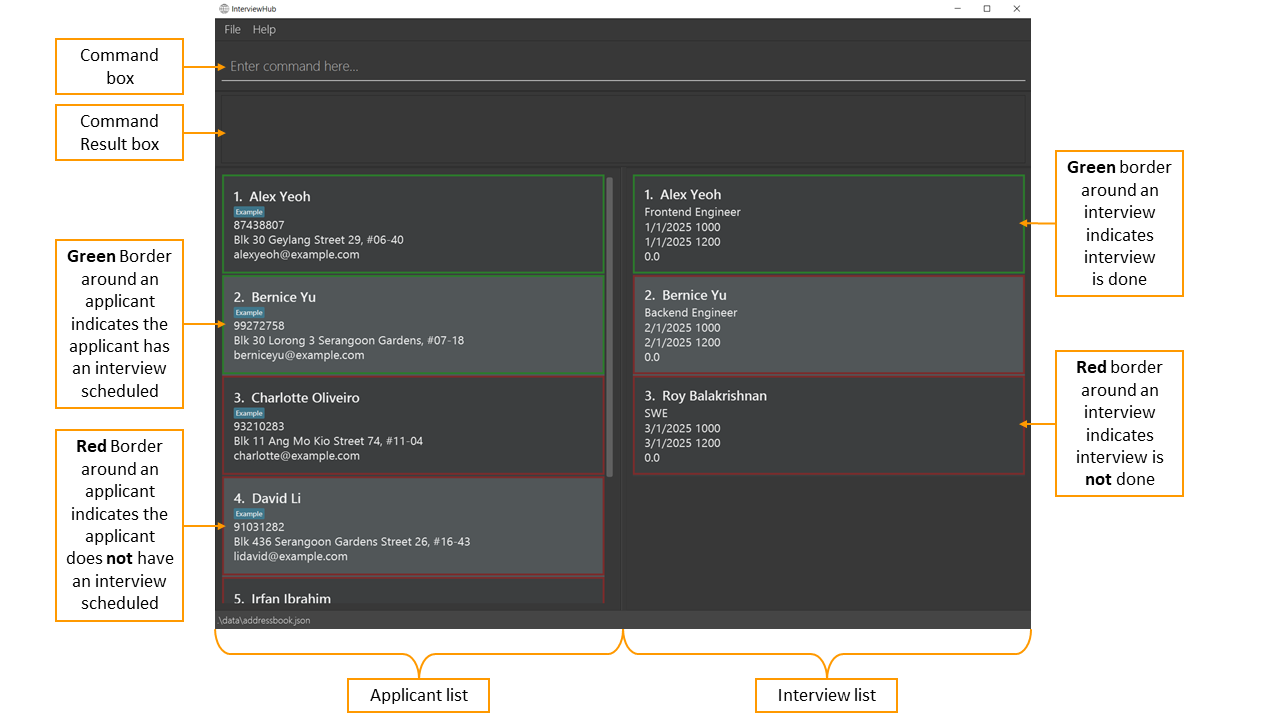
For each applicant, we see the following details:
| Information | Description |
|---|---|
| Name | The full name of the applicant |
| Tags | Custom keywords for categorizing the applicant (if any) |
| Phone | The mobile phone number of the applicant |
| Address | The residential address of the applicant |
| The email address of the applicant |
For each interview, we see the following details:
| Information | Description |
|---|---|
| Name | The full name of the applicant |
| Job Role | The job role which the applicant is applying for |
| Start Time | Start time of the interview |
| End Time | Projected end time of the interview |
| Rating | Interview performance rating of the applicant (from 0.0 - 5.0) |
Return to the Table of Contents
Features
![]() Notes about the command format:
Notes about the command format:
-
Words in
UPPER_CASEare the parameters to be supplied by the user.
e.g. inadd-a n/NAME,NAMEis a parameter which can be used asadd-a n/John Doe. -
Items in square brackets are optional.
e.g.n/NAME [t/TAG]can be used asn/John Doe t/friendor asn/John Doe. -
Items with
… after them can be used multiple times including zero times.
e.g.[t/TAG]…can be used ast/friend,t/friend t/familyetc. -
Items with
(S)after them can be used multiple times without the tag.
e.g.n/KEYWORD(S)can be used asn/John,n/John Alice Bob -
Parameters can be in any order.
e.g. if the command specifiesn/NAME p/PHONE,p/PHONE n/NAMEis also acceptable. -
Extraneous parameters for commands that do not take in parameters (such as
help,list-i,list-a,list-i-done,list-i-not-done,list-i-today,sort-rate,sort-time,exit, andclear) will be ignored.
e.g. if the command specifieshelp 123, it will be interpreted ashelp. -
List of accepted date formats:
- DD/MM/YYYY and time:
16 Jan 2024 TIME16 January 2024 TIME16-01-2024 TIME16-01-24 TIME16/01/2024 TIME16/01/24 TIME
- MM, DD and time:
16 Jan TIME16 January TIME16/1 TIME16/01 TIME
- The
TIMEplaceholder can be replaced with the formats below:15153.15pm3pm
- The
TIMEmust be between 9am to 5pm. - If the date is a parameter for the
list-freetimecommand, please omitTIMEand enter the date only (e.g.16 May 2024)
- DD/MM/YYYY and time:
General Features
Viewing help : help
A pop-up window, containing the link as shown below, will appear to guide you to the InterviewHub User Guide.

Format: help
Return to the Table of Contents
Exiting the program : exit
Exits InterviewHub.
Format: exit
Return to the Table of Contents
Clearing all applicants and interviews : clear
Clears all applicants and interviews from InterviewHub.
Format: clear
![]() Warning:
Warning:
- This action is irreversible. Please proceed with caution.
Return to the Table of Contents
Saving the data
Data in InterviewHub are automatically saved to the hard disk after any command that changes the data. There is no need for manual saving.
Return to the Table of Contents
Applicant Management Features
Adding an applicant : add-a
Adds an applicant to InterviewHub.
Format: add-a n/NAME p/PHONE e/EMAIL a/ADDRESS [t/TAG]...
| Parameter | Representation | Constraints |
|---|---|---|
NAME |
The full name of the applicant | Must contain only alphanumeric characters and cannot be blank |
PHONE |
The mobile phone number of the applicant | Must contain only numbers and be at least 3 digits long |
EMAIL |
The email address of the applicant | Must be in the format: local-part@domain
|
ADDRESS |
The residential address of the applicant | No constraints as long as it is not blank |
TAG |
Custom keyword for categorizing the applicant | Must be a single word containing only alphanumeric characters |
Examples:
-
add-a n/James Ho p/22224444 e/jamesho@example.com a/123, Clementi Rd, 1234665 t/Engineer t/Frontend.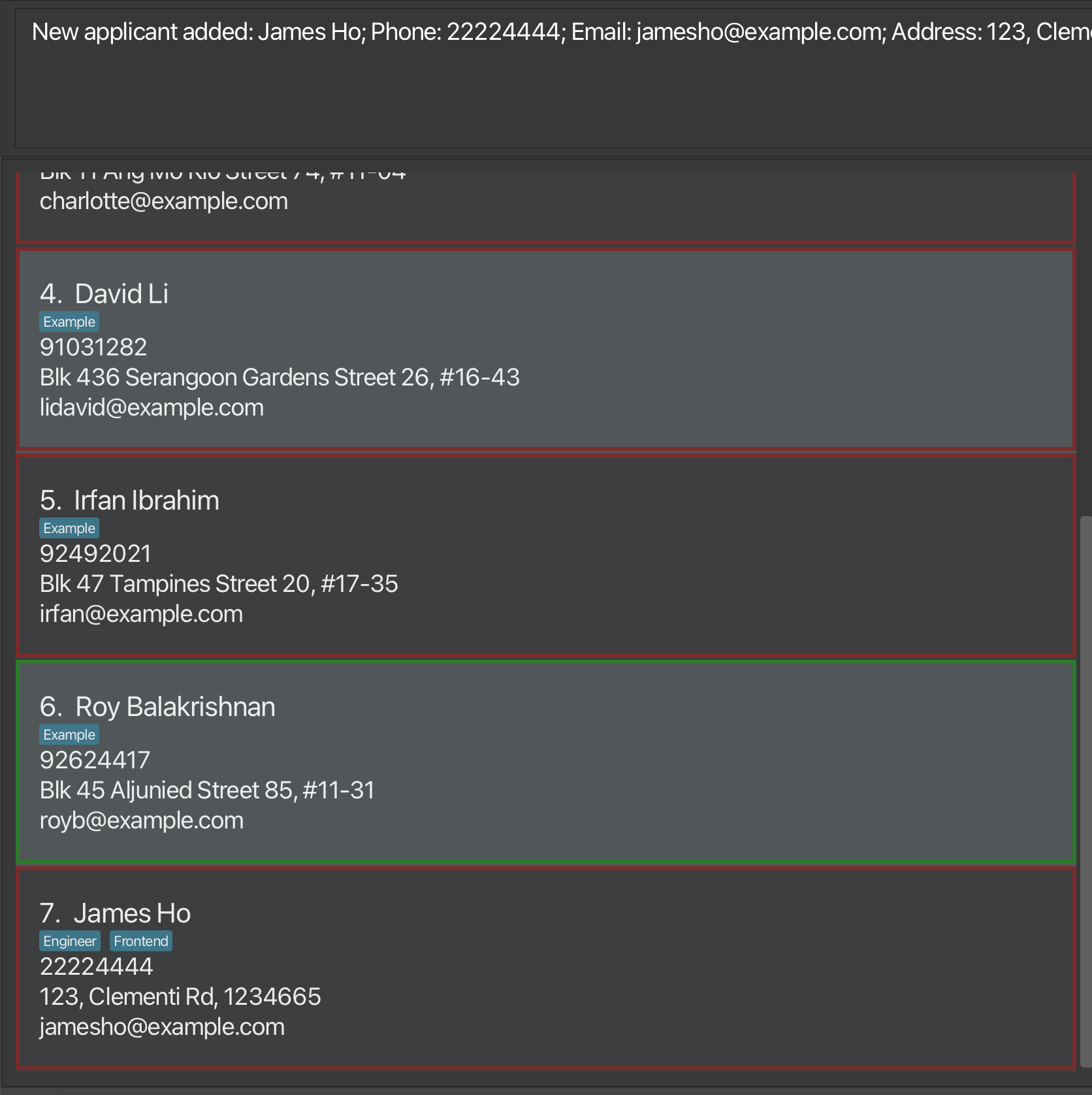
Return to the Table of Contents
Deleting an applicant : delete-a
Deletes the applicant at the specified APPLICANT_INDEX from InterviewHub.
Format: delete-a APPLICANT_INDEX
| Parameter | Representation | Constraints |
|---|---|---|
APPLICANT_INDEX |
The index of the target applicant as shown in the applicant list | Must be a positive unsigned integer and must not exceed the size of the current displayed applicant list |
![]() Note about the command usage.
Note about the command usage.
- Deleting an applicant will also cause any interview the applicant has to be deleted.
![]() Warning:
Warning:
- This action is irreversible. Please proceed with caution.
Examples:
-
delete-a 1deletes the 1st applicant in the address book.
Return to the Table of Contents
Editing an applicant : edit-a
Edits the applicant at the specified APPLICANT_INDEX from InterviewHub.
Format: edit-a APPLICANT_INDEX [n/NAME] [p/PHONE] [e/EMAIL] [a/ADDRESS] [t/TAG]...
| Parameter | Representation | Constraints |
|---|---|---|
APPLICANT_INDEX |
The index of the target applicant as shown in the applicant list | Must be a positive unsigned integer and must not exceed the size of the current displayed applicant list |
NAME |
The full name of the applicant | Must contain only alphanumeric characters and cannot be blank |
PHONE |
The mobile phone number of the applicant | Must contain only numbers and be at least 3 digits long |
EMAIL |
The email address of the applicant | Must be in the format: local-part@domain
|
ADDRESS |
The residential address of the applicant | No constraints as long as it is not blank |
TAG |
Custom keyword for categorizing the applicant | Must be a single word containing only alphanumeric characters |
![]() Note about the command usage.
Note about the command usage.
- At least one of the optional fields must be provided.
- Existing values will be updated to the input values.
- Editing the name of an applicant will also be reflected in any interview the applicant has.
Examples:
-
edit-a 1 n/John DoeEdits the name of the 1st applicant to beJohn Doe. -
edit-a 2 p/91234567 e/johndoe@example.comEdits the phone number and email address of the 2nd applicant to be91234567andjohndoe@example.comrespectively.Before:
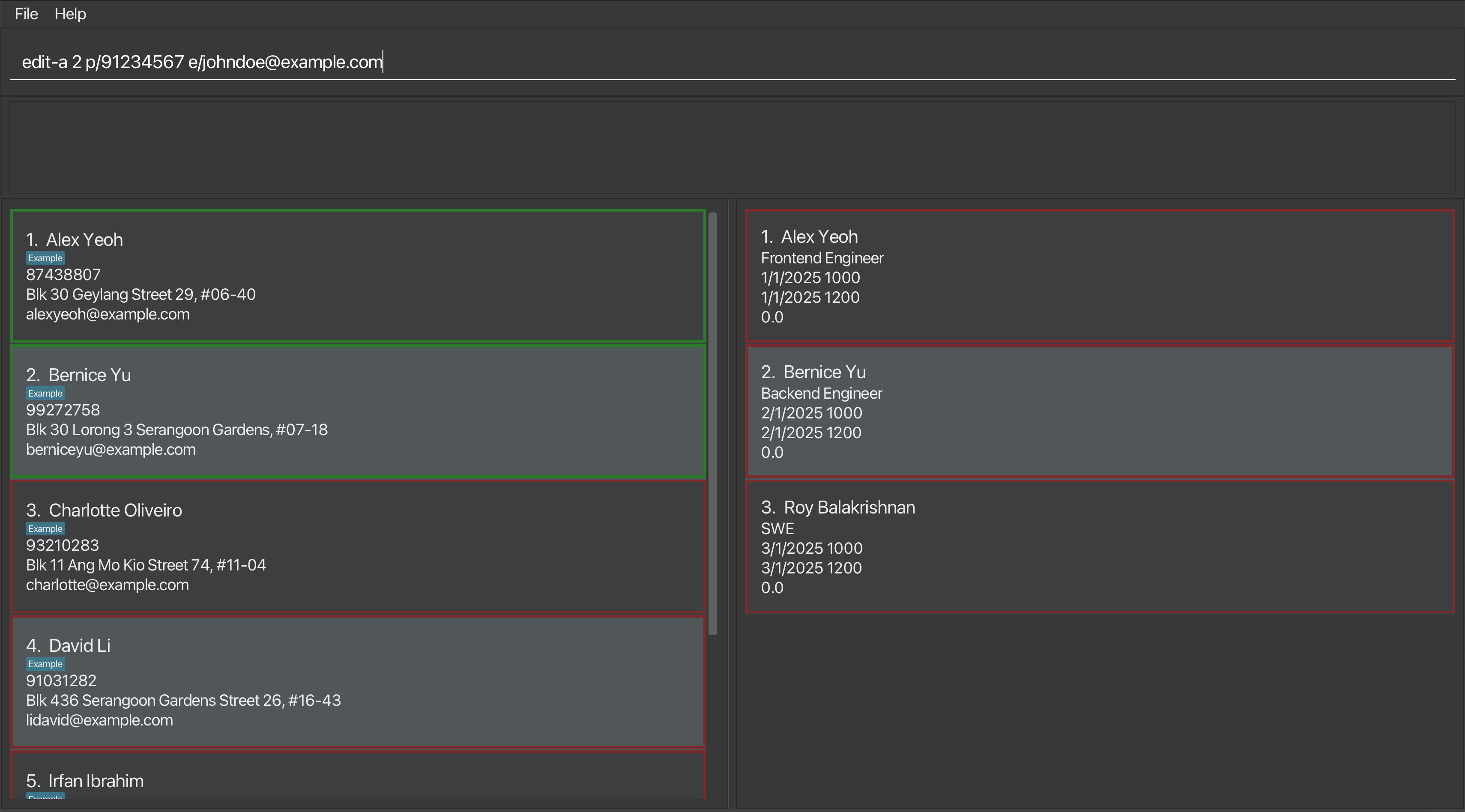 After:
After:

Return to the Table of Contents
Finding applicants : find-a
Finds applicants whose attributes contain any of the given keywords or number.
Format: find-a [n/KEYWORD(S)] [p/NUMBER]
[e/KEYWORD(S)] [a/KEYWORD(S)] [t/KEYWORD(S)]
The table below summarises how each field is matched in the search.
| Prefix | Field | Match | Examples |
|---|---|---|---|
n/ |
NAME |
Only full words will be matched |
Han will match Han Bo but not Hans Bo
|
p/ |
PHONE |
Partial numbers will be matched |
987 will match 98765432
|
e/ |
EMAIL |
Must be an exact match to the entire email, the part before the @, or the part after the @
|
john, example.com and john@example.com will all match john@example.com
|
a/ |
ADDRESS |
Only full words will be matched |
Serangoon will match Serangoon Road but not Serangoons road
|
t/ |
TAG |
Only full words will be matched |
Eng will match Eng but not Engineer
|
![]() Note about the command usage.
Note about the command usage.
- Any of the fields (name, phone, email, address, tags) can be searched
- At least one of the optional fields must be provided
- Multiple keywords must be either space or comma separated
- The search is case-insensitive. e.g.
hanswill matchHans - The order of the keywords does not matter. e.g.
Hans Bowill matchBo Hans - Applicants matching at least one keyword will be returned (i.e.
ORsearch). e.g.Hans Bowill returnHans Gruber,Bo Yang
Examples:
-
find-a n/alex davidreturnsAlex Yeoh,David Li

-
find-a p/874 a/serangoon angreturns97438807,Serangoon Gardens,Serangoon Gardens Street,Ang Mo Kio

Return to the Table of Contents
Listing all applicants : list-a
Shows a list of all applicants in InterviewHub on the GUI.
Format: list-a
Return to the Table of Contents
Interview Management Features
Adding an interview : add-i
Adds an interview to InterviewHub.
Format: add-i app/APPLICANT_INDEX jr/JOB_ROLE start/START_DATE_AND_TIME end/END_DATE_AND_TIME
| Parameter | Representation | Constraints |
|---|---|---|
APPLICANT_INDEX |
The index of the target applicant as shown in the applicant list | Must be a positive unsigned integer and must not exceed the size of the current displayed applicant list |
JOB_ROLE |
The job role which the applicant is applying for | No constraint |
START_DATE_AND_TIME |
Starting time of the interview | Must be in one of the accepted formats, before the end time and on the same day as the end time |
END_DATE_AND_TIME |
Ending time of the interview | Must be in one of the accepted formats, after the start time and on the same day as the start time |
JOB_ROLE allows empty strings to be entered to handle situations where the applicant is applying
to the company in general.
Examples of accepted date formats (full list here):
- DD/MM/YYYY and time:
16 May 2024 151516 May 2024 3.15pm
- MM, DD and time:
16 May 151516 May 3.15pm
Example:
Result of add-i app/3 jr/Software engineer start/12-12-2023 1400 end/12-12-2023 1500
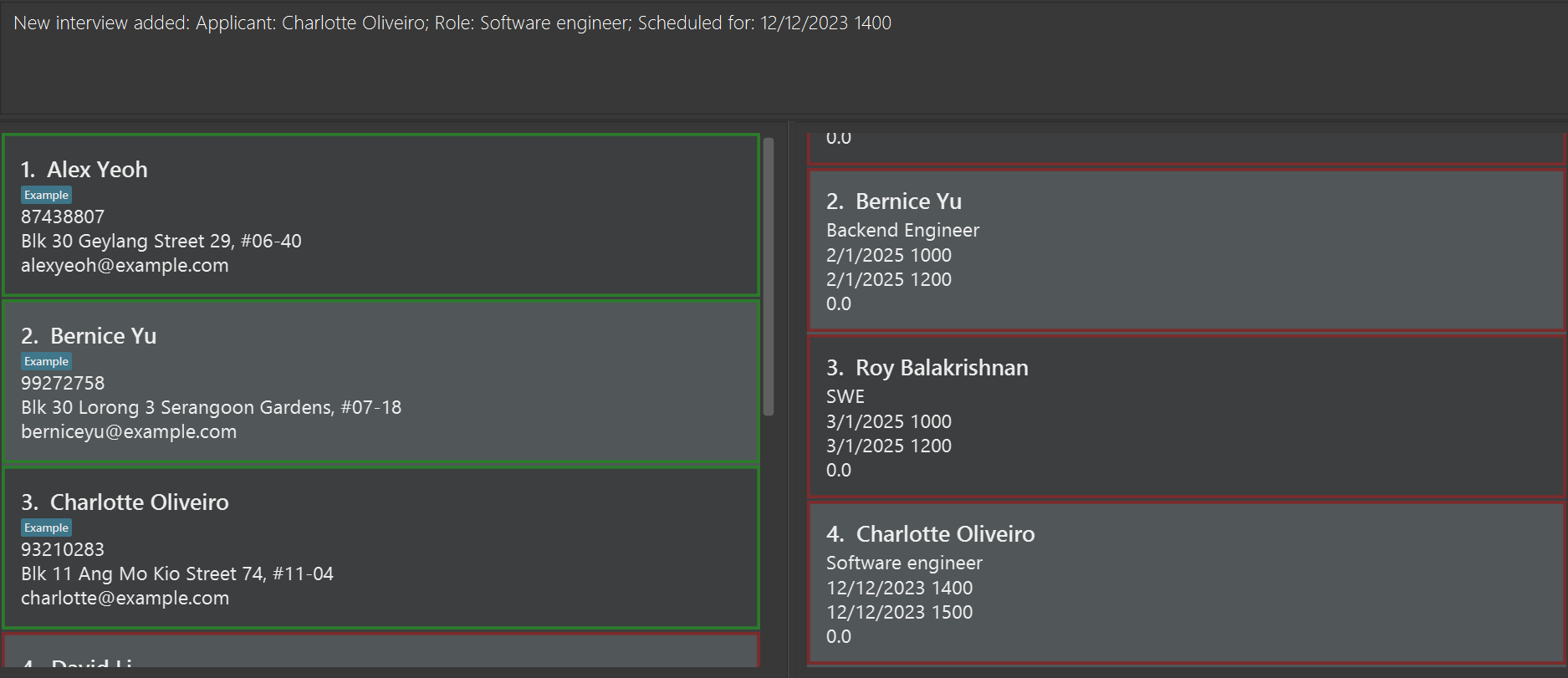
A common error that you may encounter is entering an invalid time or time format, please refer to the informative error message or accepted formats list and reenter the command with proper parameters
After add-i app/4 jr/Software engineer start/Next Tuesday 4pm end/6pm that day:

Return to the Table of Contents
Deleting an interview : delete-i
Deletes the interview at the specified INTERVIEW_INDEX from InterviewHub.
Format: delete-i INTERVIEW_INDEX
| Parameter | Representation | Constraints |
|---|---|---|
INTERVIEW_INDEX |
The index of the target interview as shown in the interview list | Must be a positive unsigned integer and must not exceed the size of the current displayed interview list |
![]() Warning:
Warning:
- This action is irreversible. Please proceed with caution.
Examples:
-
delete-i 1deletes the 1st interview in InterviewHub.
Before delete-i: You should see the applicant and interview list (may be filtered depending on whether your previous commands filtered the lists)

After delete-i 1: You should see a success message in the command result box. And the targeted interview is removed from the interview list.
Also, the applicant associated with the interview will have their border change to red.

If you do not specify a valid index (or an index at all) you may encounter one of the informative error messages appearing in the command result box that should assist you with troubleshooting:
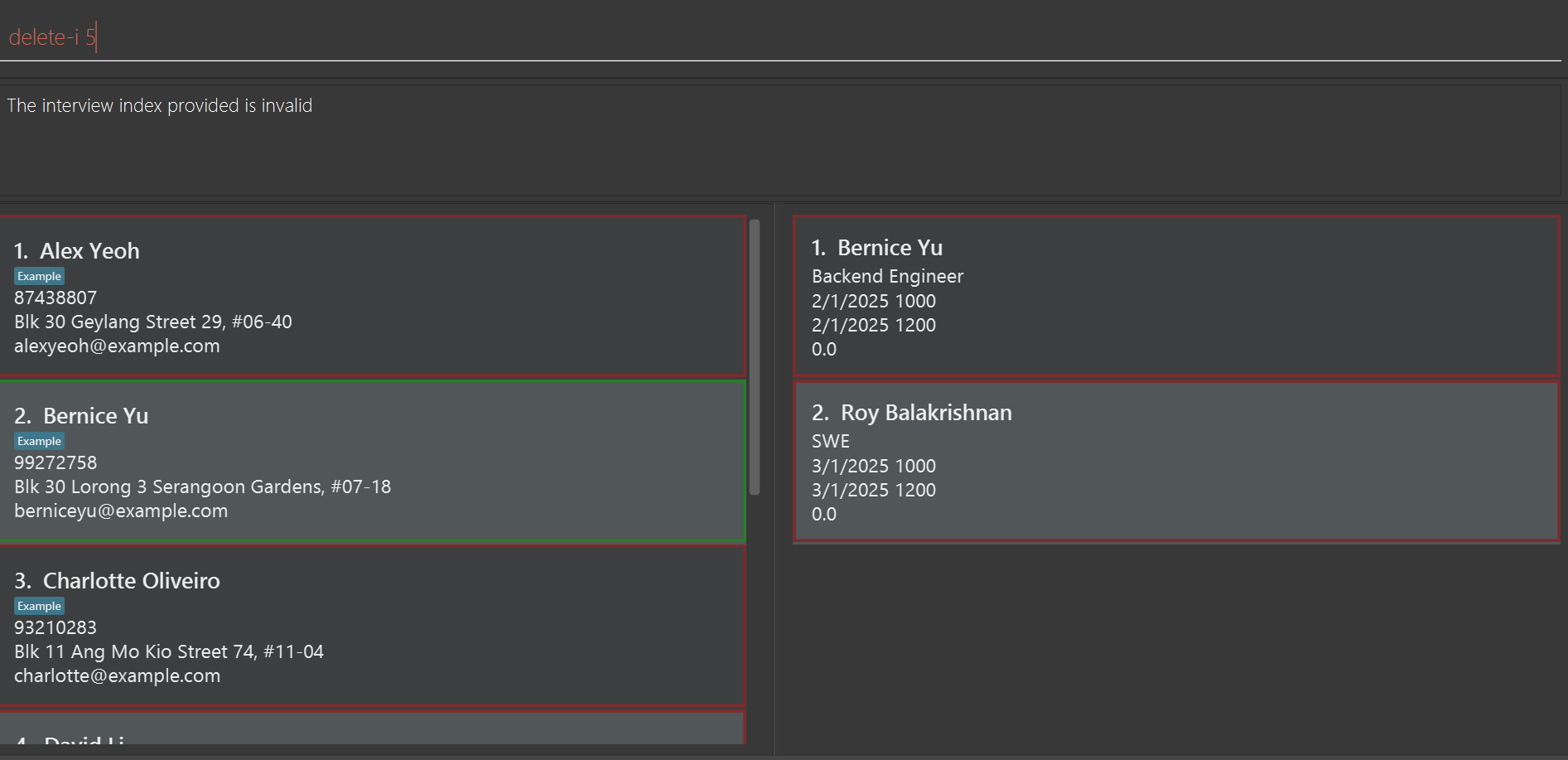
Return to the Table of Contents
Editing an interview : edit-i
Edits an existing interview at the specified INTERVIEW_INDEX.
Format: edit-i INTERVIEW_INDEX [jr/JOB_ROLE] [start/START_DATE_AND_TIME] [end/END_DATE_AND_TIME]
| Parameter | Representation | Constraints |
|---|---|---|
INTERVIEW_INDEX |
The index of the target interview as shown in the interview list | Must be a positive unsigned integer and must not exceed the size of the current displayed interview list |
JOB_ROLE |
The role the applicant is interviewing for | No constraints |
START_DATE_AND_TIME |
Starting time of the interview | Must be one of the accepted formats, before the end time and on the same day as the end time |
END_DATE_AND_TIME |
Ending time of the interview | Must be one of the accepted formats, after the start time and on the same day as the start time |
![]() Note about the command usage.
Note about the command usage.
- At least one of the optional fields must be provided.
- Existing values will be updated to the input values.
- To edit the
RATINGfield (re-rating an interview), please refer to the rate command. - An interview that is marked as done can no longer be edited.
Examples of accepted date formats (full list here):
- DD/MM/YYYY and time:
16 May 2024 151516 May 2024 3.15pm
- MM, DD and time:
16 May 151516 May 3.15pm
Examples:
-
edit-i 1 jr/software-engineerEdits the job role of the 1st interview to besoftware-engineer. -
edit-i 2 jr/data-analystEdits the job role of the 2nd interview to bedata-analyst.
View of the Interview list before editing:
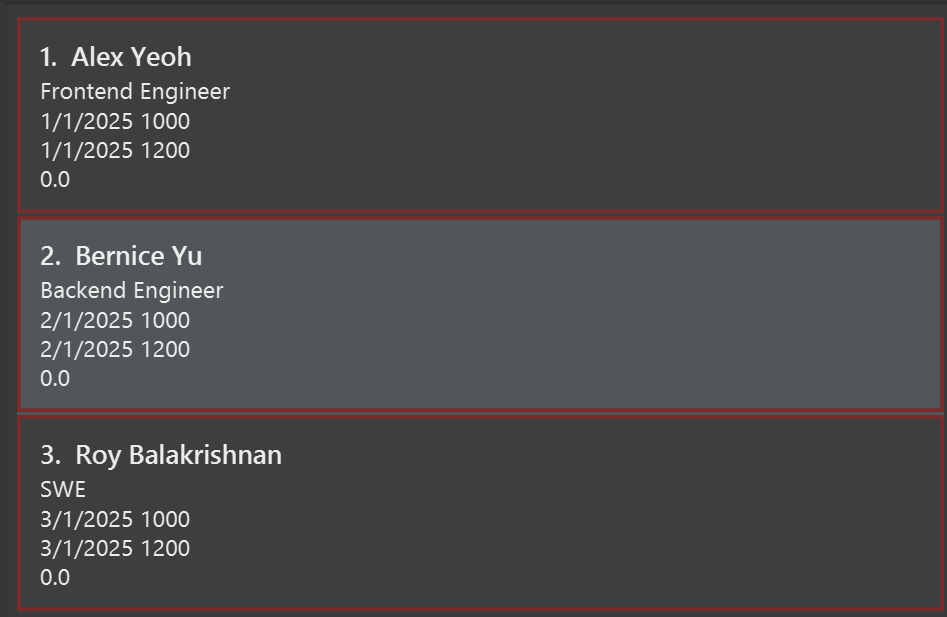
View of the application after edit-i 1 jr/Network Engineer:
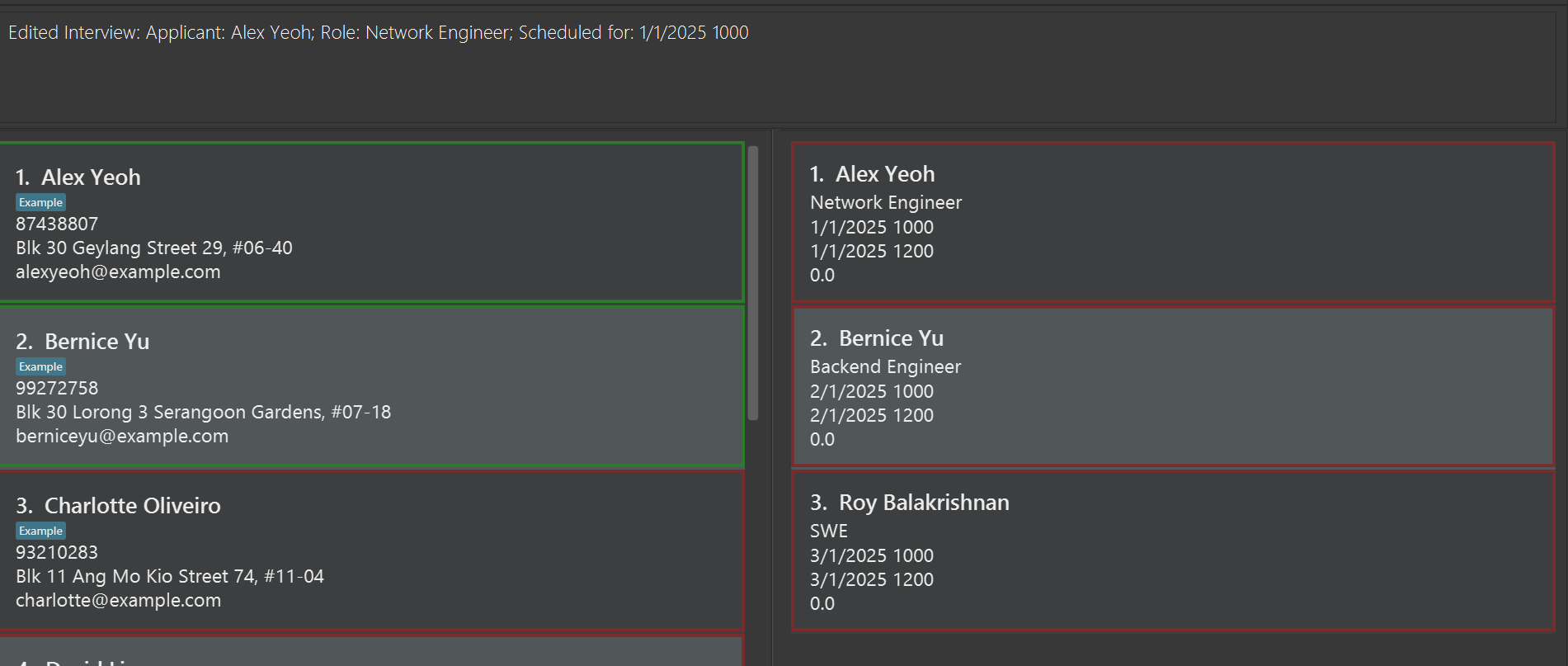 You can see that Alex Yeoh’s role has been updated from Frontend Engineer to Network Engineer
You can see that Alex Yeoh’s role has been updated from Frontend Engineer to Network Engineer
Return to the Table of Contents
Finding interviews by job role : find-i
Find interviews in which job roles contain any of the given keywords.
Format: find-i KEYWORD(S)
| Parameter | Representation | Constraints |
|---|---|---|
KEYWORD |
The job role the interview is assigned for | Each keyword must not contain any spaces, otherwise it will be treated as multiple keywords |
![]() Note about the command usage.
Note about the command usage.
- The search is case-insensitive. e.g.
ANALYSTwill matchanalyst - Must provide at least one keyword
- The order of the keywords does not matter. e.g.
Software Engineerwill matchEngineer Software - Only the job role is searched.
- Only full words will be matched e.g.
Analystwill not matchAnalysts - Interviews matching at least one keyword will be returned (i.e.
ORsearch). e.g.Software Engineerwill return interviews with the job role ofSoftware DeveloperandSystem Engineer
Examples:
-
find-i software datareturnsSoftware EngineerandData Analyst.
Return to the Table of Contents
Listing all interviews : list-i
Shows a list of all interviews in InterviewHub on the GUI.
Format: list-i
After list-i: You should see a success message in the command result box and the full list of interviews in the interview list
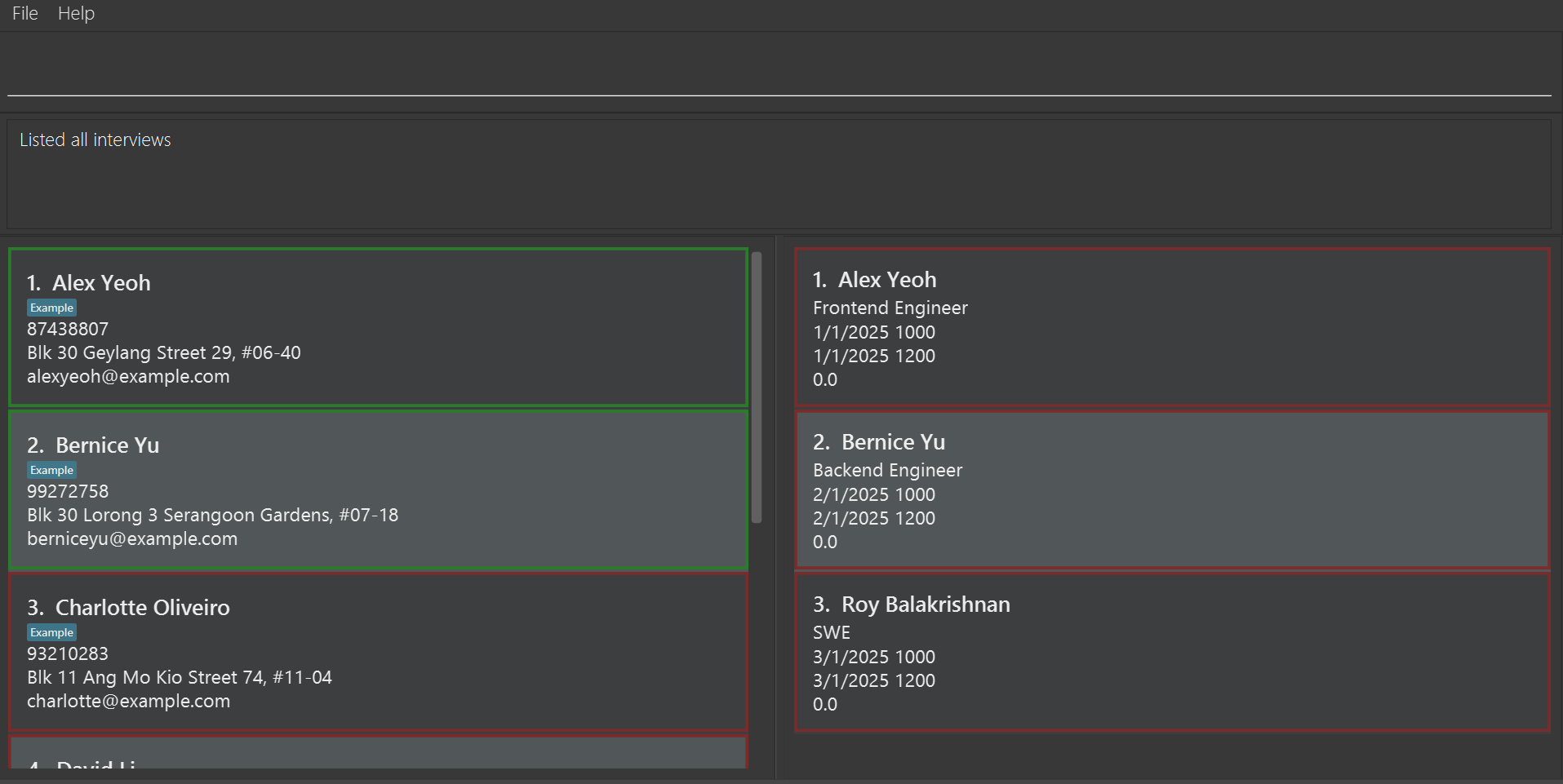
Return to the Table of Contents
Listing all free timings for the given date : list-freetime
Displays a list of all the blocks of free time the user has in
the given DATE, within the 9am to 5pm window of that day.
Format: list-freetime DATE
| Parameter | Representation | Constraints |
|---|---|---|
DATE |
The date for which the user wants to view the list of blocks of free time | The input date must be one of the accepted formats and cannot be in the past. Must contain only the date without the time |
![]() Note about the command usage.
Note about the command usage.
- Additional parameters separated by non-number characters will be accepted.
- e.g. 12-12-2024hello
- If there is no free time, there will be no blocks of
free time that will be displayed
- This indicates that the entire day is not free
- If there are no interviews on that day, the block of free time
listed will be:
from: 09:00 to: 17:00- This indicates that the entire day is free
-
If the
DATEnot valid at all, this error message will be shown:Please specify a valid date! - If the
DATEis valid but in the past, this error message will be shown:Input date cannot be in the past!
Examples:
list-freetime 03-11-2024list-freetime 5-5-2025
Return to the Table of Contents
Listing all interviews for today : list-i-today
Shows a list of the interviews in InterviewHub which are scheduled on the day the command is executed.
Format: list-i-today
![]() Note about the command usage.
Note about the command usage.
- Lists all interviews that have a start date that falls on the
day on which the user executed the command
- For example, if the user executed this command on
12/12/2023, the app will display all the interviews that the user has scheduled on12/12/2023
- For example, if the user executed this command on
- If there are no interviews scheduled on the day which the command was executed, the app will not display any interviews
- Upon successful execution of the command, this message will be
shown:
Listed all interviews today
Example: list-i-today
We have three interviews scheduled on 09/11/2023 as shown below:

Result of list-i-today on 09/11/2023.
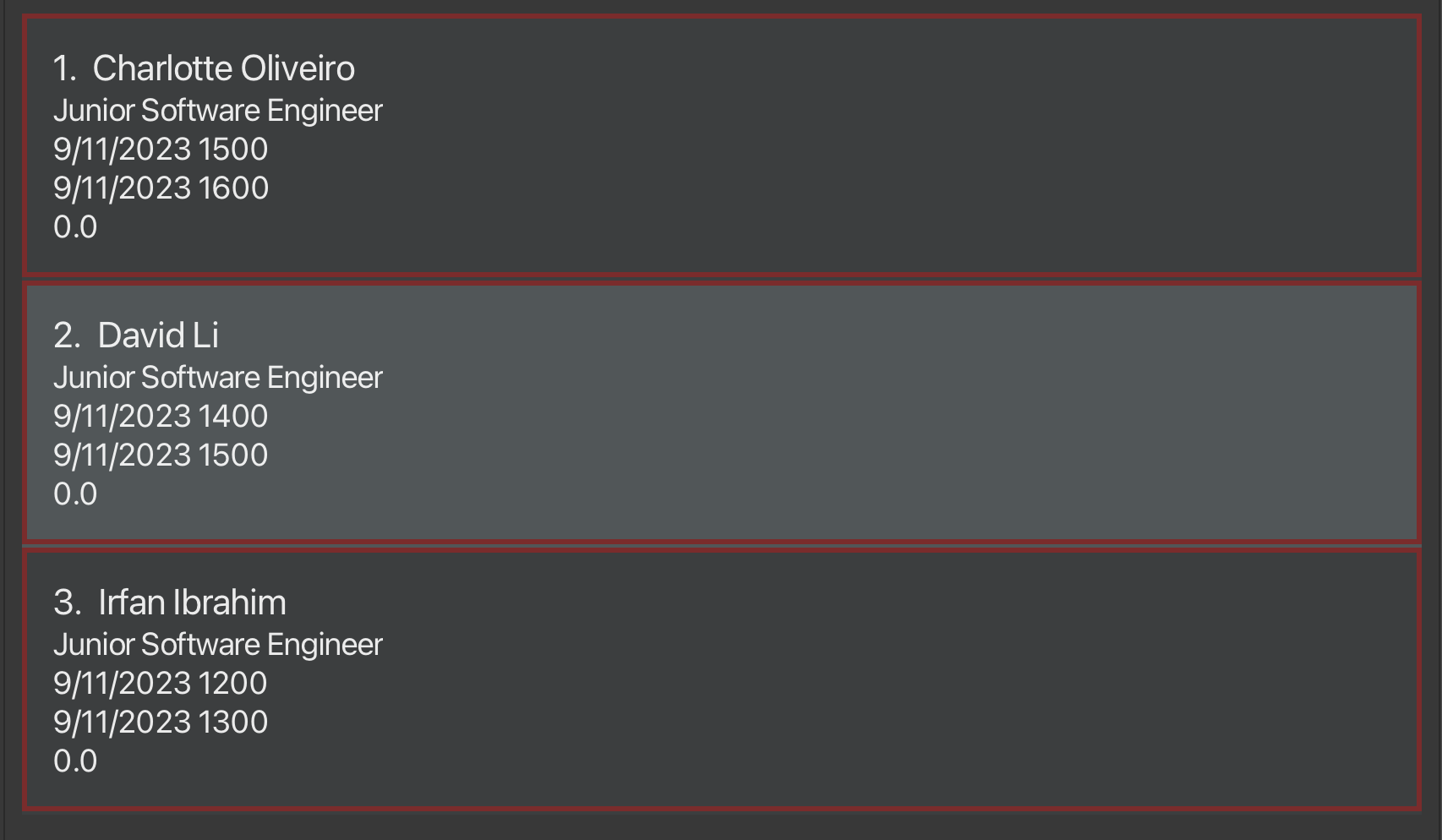
Return to the Table of Contents
Marking an interview as done : mark
Mark the specified INTERVIEW_INDEX in the InterviewHub as done.
Format: mark INTERVIEW_INDEX
| Parameter | Representation | Constraints |
|---|---|---|
INTERVIEW_INDEX |
The index of the target interview as shown in the interview list | Must be a positive unsigned integer and must not exceed the size of the current displayed interview list |
![]() Note about the command usage.
Note about the command usage.
- You can only mark interviews with a red border (i.e. interviews that are not done).
- Marking an interview that is already done will result in an error message.
Examples:
-
mark 1marks the first interview shown on the list as done. -
mark 3marks the third interview shown on the list as done.
Return to the Table of Contents
Rating an interview : rate
Rate the specified INTERVIEW_INDEX in the InterviewHub with the indicated RATING.
Format: rate INTERVIEW_INDEX RATING
![]() Note about the command usage.
Note about the command usage.
- The interview has to be marked as done before it can be rated.
- The new rating will always replace the existing rating.
| Parameter | Representation | Constraints |
|---|---|---|
INTERVIEW_INDEX |
The index of the target interview as shown in the interview list | Must be a positive unsigned integer and must not exceed the size of the current displayed interview list |
RATING |
The rating number to be assigned to the interview indicated | Must be a positive unsigned one decimal place number between 0.0 to 5.0 inclusive |
Examples:
-
rate 1 3.0rates the first interview with a rating of 3.0.
Before rating the interview at INTERVIEW_INDEX 1:

After rating the interview at INTERVIEW_INDEX 1 with a RATING of 4.0:

Return to the Table of Contents
Listing all completed interviews : list-i-done
Shows a list of all the interviews in InterviewHub that are done on the GUI.
Format: list-i-done
list-i.
Before list-i-done:
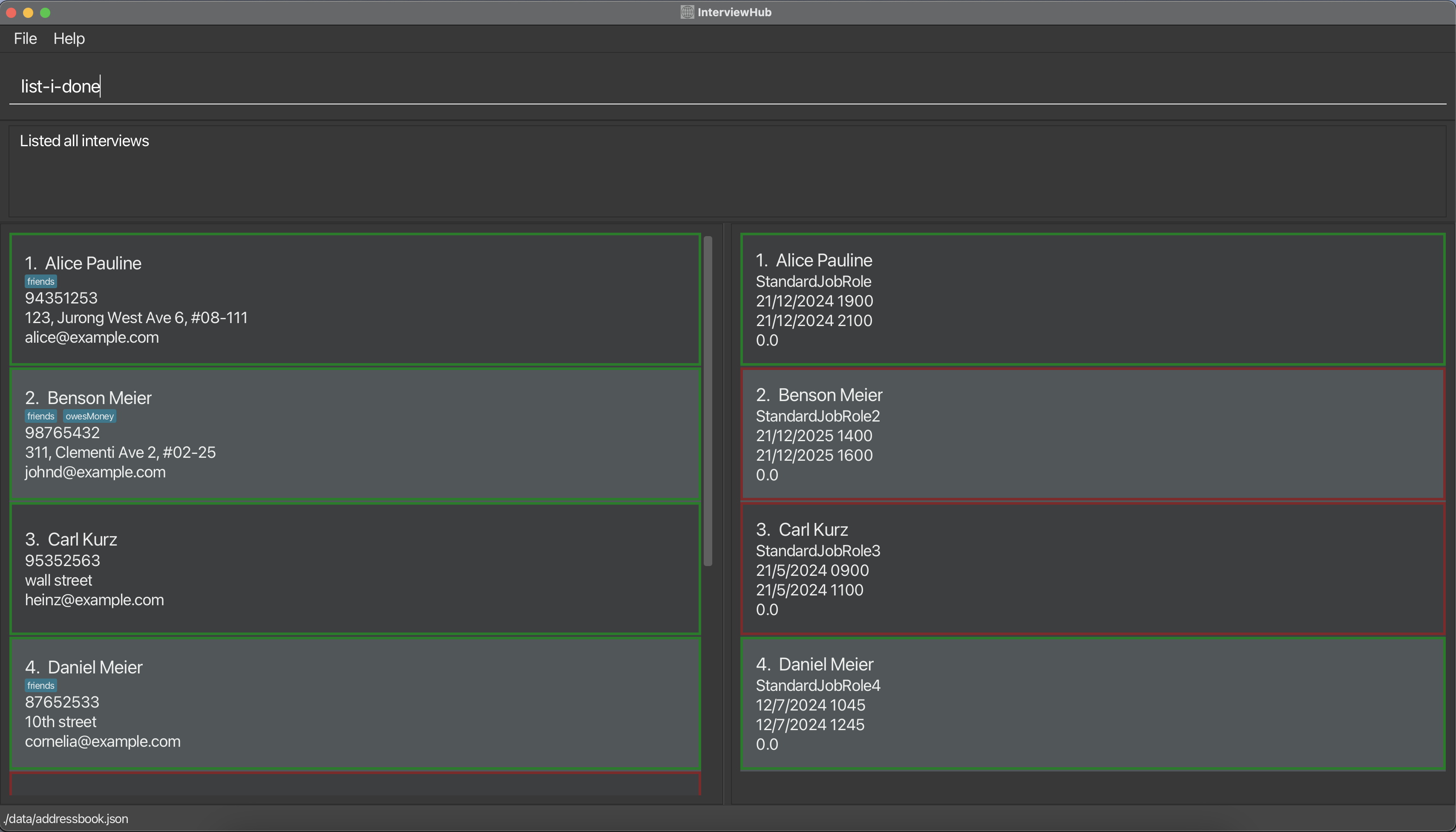
After list-i-done:
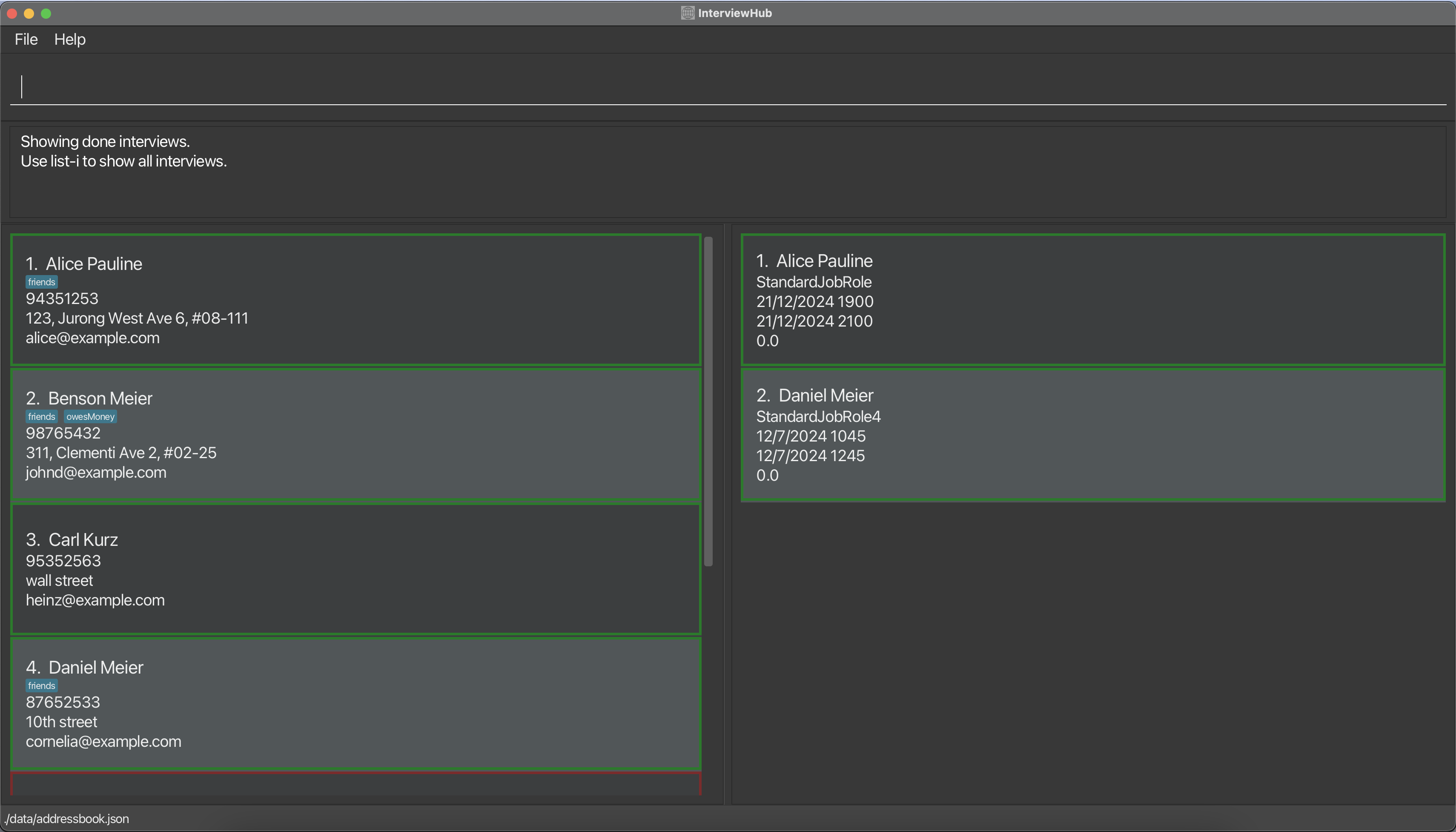
Return to the Table of Contents
Listing all incomplete interviews : list-i-not-done
Show a list of all the interviews in InterviewHub that are not done on the GUI.
Format:list-i-not-done
list-i.
Before list-i-not-done:
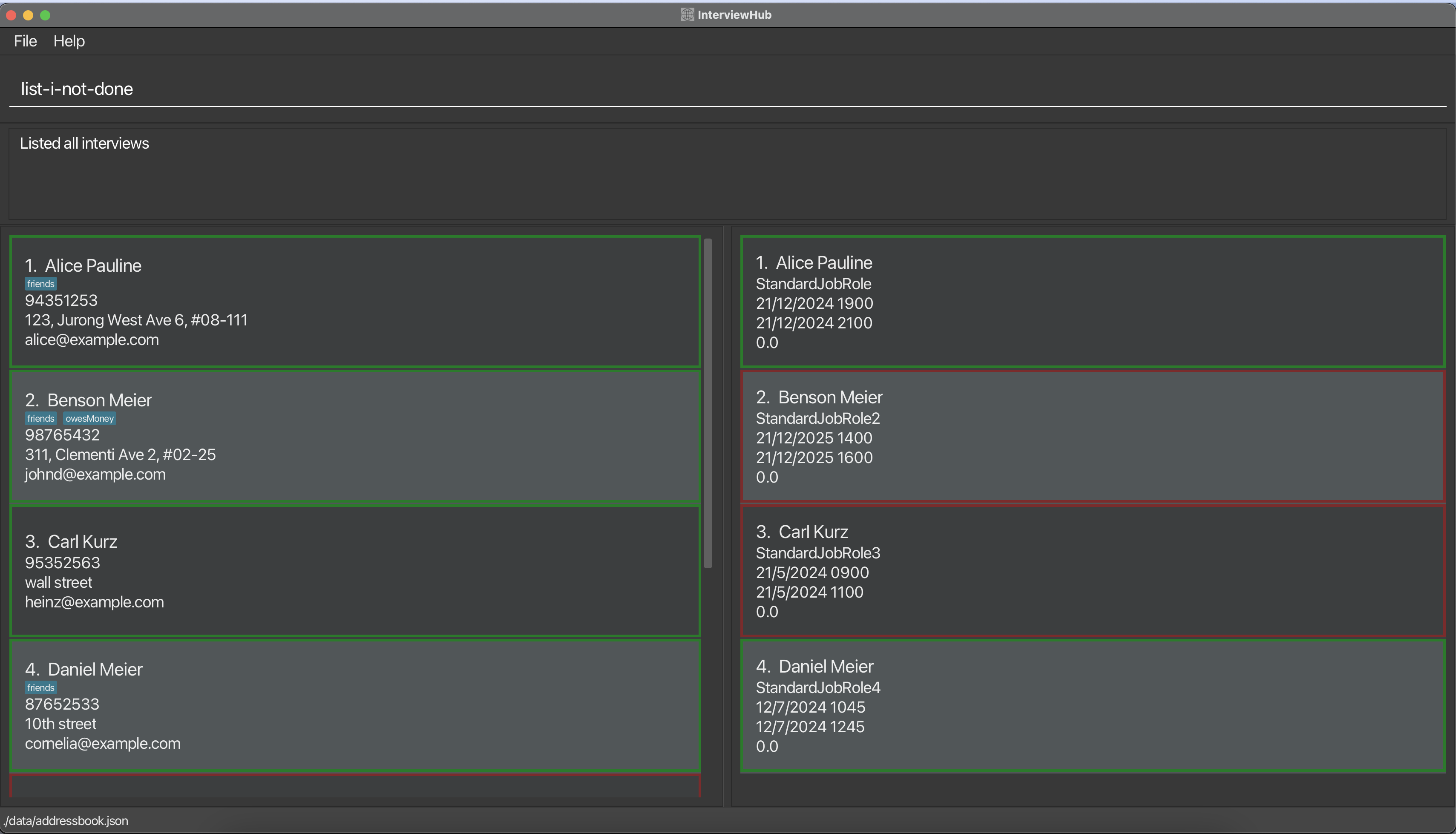
After list-i-not-done:
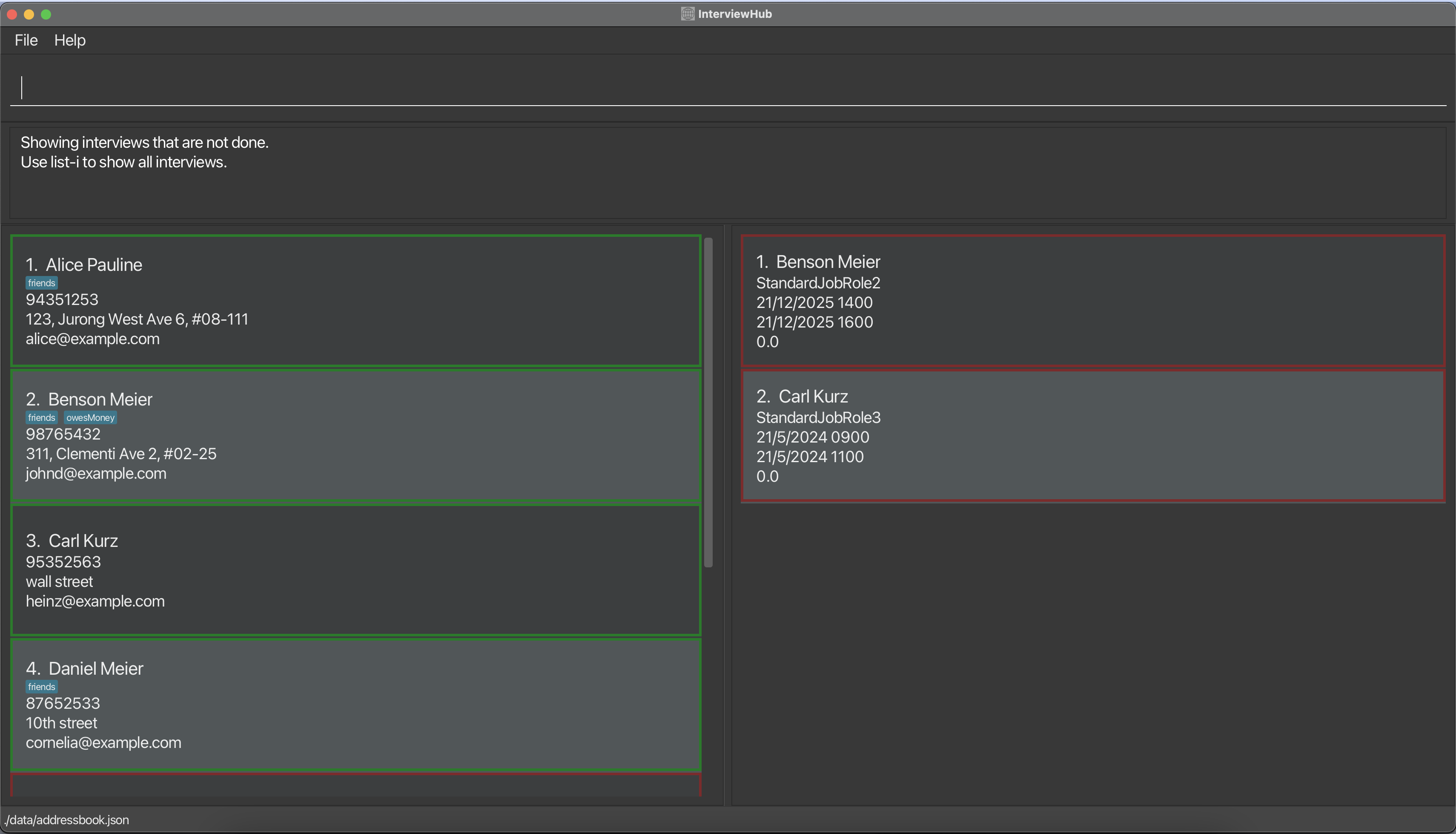
Return to the Table of Contents
Sorting interviews by rating : sort-rate
Sort the shown interview list by rating in descending order (highest to the lowest rating).
Format: sort-rate
list-i before using sort-rate.
Before sort-rate:

After sort-rate:

Return to the Table of Contents
Sorting interviews by start time : sort-time
Sort the shown interview list by interview start time in chronologically ascending order (interviews with earlier start times will be shown first).
Format: sort-time
list-i before using sort-time.
Before sort-time:
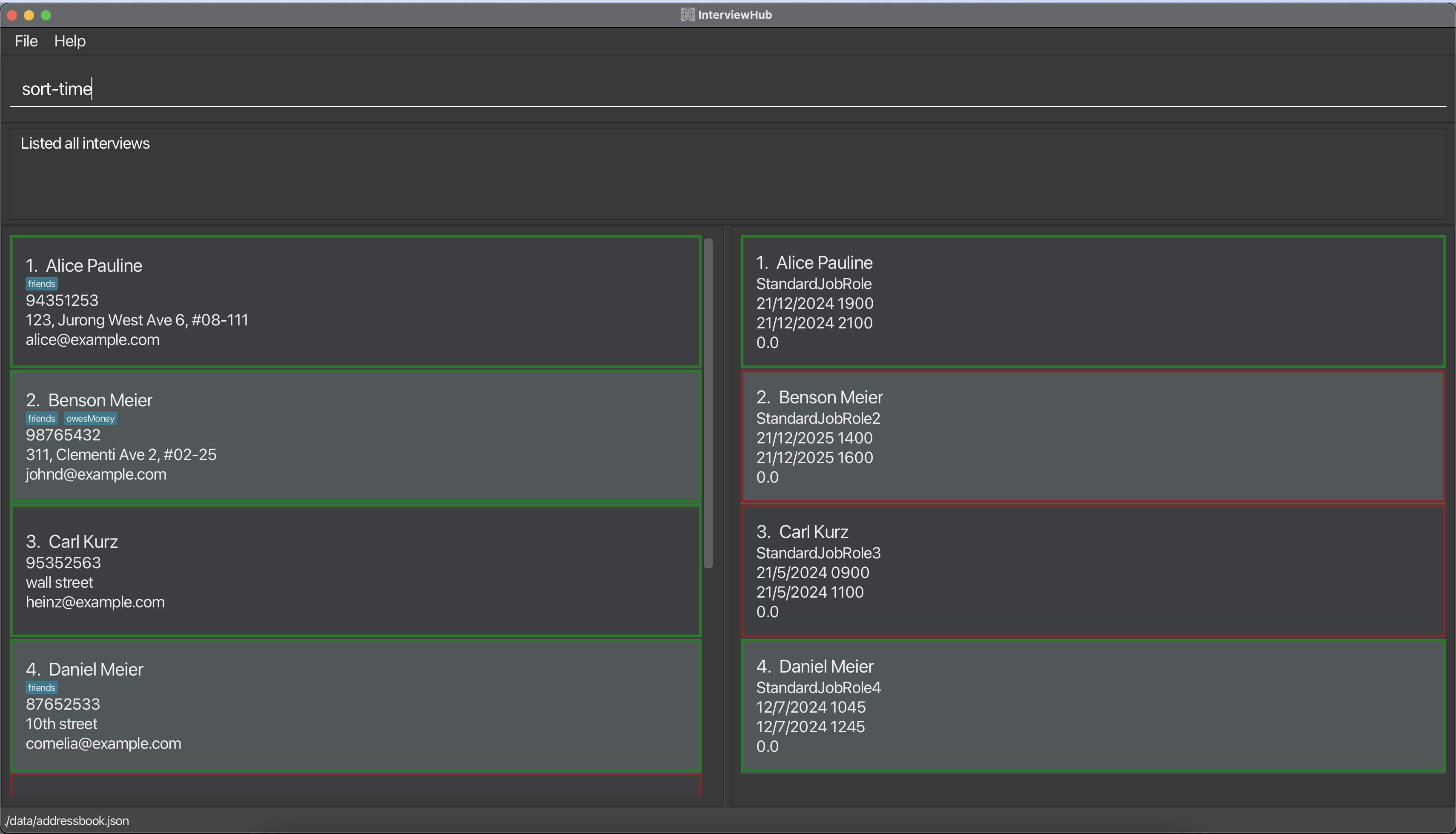
After sort-time:
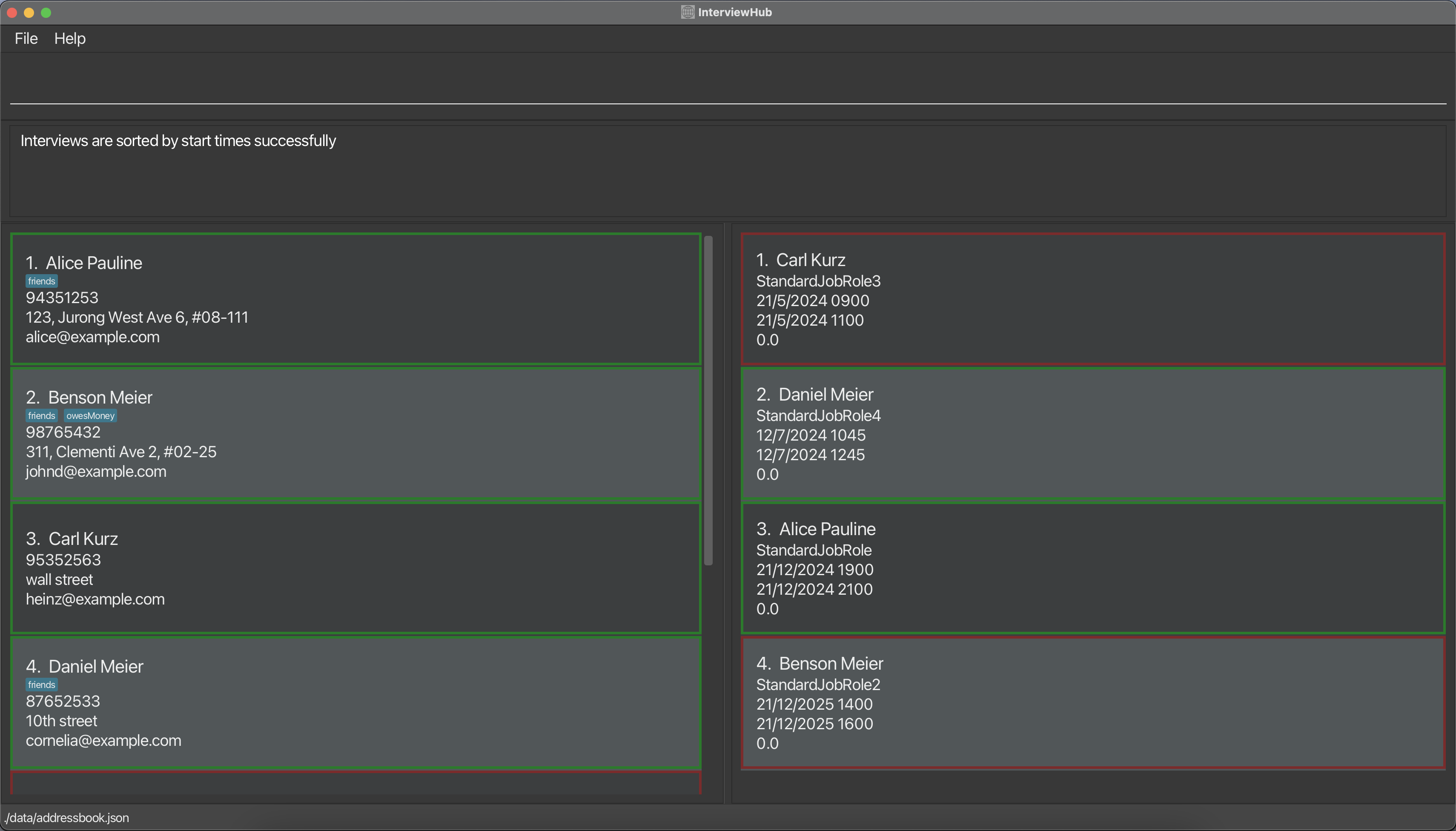
Return to the Table of Contents
Editing the data file
InterviewHub data are saved automatically as a JSON file [JAR file location]/data/interviewhub.json. Advanced users are welcome to update data directly by editing that data file.
Return to the Table of Contents
Frequently Asked Questions
Q: How do I transfer my data to another Computer?
A: Install the app in the other computer and overwrite the empty data file it creates with the file that contains the data of your previous InterviewHub home folder.
Q: How do I check if I have the correct version of Java installed?
A: You can check the version of Java installed in your computer by opening the terminal and running the java --version command.
The correct version of Java required to run InterviewHub is Java 11 or above. If you do not have Java installed, or if your current version is lower than 11, you can download the correct version here.
Q: Do I need an active internet connection to use InterviewHub?
A: No. It is an offline app.
Return to the Table of Contents
Known issues
-
When using multiple screens, if you move the application to a secondary screen, and later switch to using only the primary screen, the GUI will open off-screen. The remedy is to delete the
preferences.jsonfile created by the application before running the application again.
Return to the Table of Contents
Command Summary
General Commands
| Action | Format, Examples |
|---|---|
| Clear all applicants and interviews | clear |
| Help | help |
| Exit | exit |
Return to the Table of Contents
Applicant Management Commands
| Action | Format, Examples |
|---|---|
| Add applicant |
add-a n/NAME p/PHONE e/EMAIL a/ADDRESS [t/TAG] e.g., add-a n/James Ho p/22224444 e/jamesho@example.com a/123, Clementi Rd, 1234665 t/friend t/colleague
|
| Delete applicant |
delete-a APPLICANT_INDEXe.g., delete-a 3
|
| Edit applicant |
edit-a APPLICANT_INDEX [n/NAME] [p/PHONE] [e/EMAIL] [a/ADDRESS] [t/TAG]...e.g., edit-a 2 n/John Doe
|
| Find applicant |
find-a [n/KEYWORD(S)] [p/NUMBER] [e/KEYWORD(S)] [a/KEYWORD(S)] [t/KEYWORD(S)] e.g., find-a n/John Bob p/98765432 e/john@example.com
|
| List applicants | list-a |
Return to the Table of Contents
Interview Management Commands
| Action | Format, Examples |
|---|---|
| Add interview |
add-i app/APPLICANT_INDEX jr/JOB_ROLE start/START_DATE_AND_TIME end/END_DATE_AND_TIME e.g., add-i app/3 jr/Software Engineer start/12-12-2024 1500 end/12-12-2024 1600
|
| Delete interview |
delete-i INTERVIEW_INDEXe.g., delete-i 3
|
| Edit interview |
edit-i INTERVIEW_INDEX [jr/JOB_ROLE] [start/START_DATE_AND_TIME] [end/END_DATE_AND_TIME] e.g., edit-i 2 jr/software-engineer
|
| Find interview by job |
find-i KEYWORD(S)e.g., find-i software-engineer
|
| List interviews |
list-i e.g. list-i
|
| List free time |
list-freetime INTERVIEW_DATETIME e.g, list-freetime 12-12-2023, list-freetime 12/12/2023, list-freetime 12/12, list-freetime 12 Dec
|
| List interviews for today |
list-i-today e.g. list-i-today
|
| Mark interview as done |
mark INTERVIEW_INDEX e.g., mark 3
|
| Rate interview |
rate INTERVIEW_INDEX RATING e.g., rate 1 3.0
|
| List completed interviews |
list-i-done e.g. list-i-done
|
| List incomplete interviews |
list-i-not-done e.g. list-i-not-done
|
| Sort interviews by rating |
sort-rate e.g. sort-rate
|
| Sort interviews by start time |
sort-time e.g. sort-time
|
Return to the Table of Contents
Glossary
| Term | Definition |
|---|---|
| JAR File | JAR (Java Archive) files are archive files that include a Java-specific manifest file. They are built on the ZIP format and typically have a .jar file extension. |
| JSON File | JSON (JavaScript Object Notation) is a lightweight data interchange format that is easy to understand and use. |
| CLI | A CLI (Command Line Interface) is a means of interacting with a computer program by inputting lines of text called command-lines. |
| GUI | A GUI (Graphical User Interface) is user interface that allows users to interact with the program with interactive visual components instead of text-based UIs, typed command labels or text navigation. |